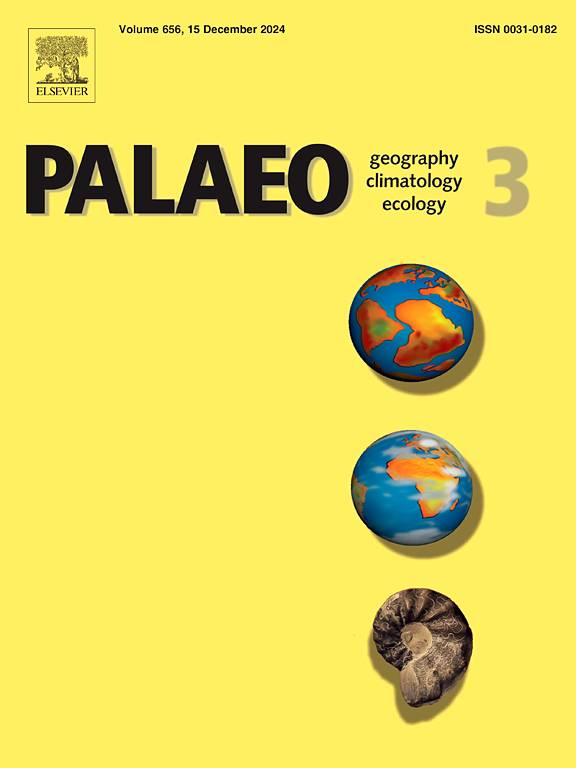Flint formation and astronomical pacing in the Maastrichtian chalk of northwestern Europe
IF 2.7
2区 地球科学
Q2 GEOGRAPHY, PHYSICAL
Palaeogeography, Palaeoclimatology, Palaeoecology
Pub Date : 2025-06-12
DOI:10.1016/j.palaeo.2025.113095
引用次数: 0
Abstract
In Upper Cretaceous chalk sequences, the widespread occurrence of flint, as well as a possible astronomical pacing of their often-encountered rhythmic distribution, remains poorly constrained. The Campanian-Maastrichtian Hallembaye chalk succession (Maastrichtian type area, northeast Belgium) is characterized by the gradual evolution from no flint bands at its base to the regular presence of well-developed flint bands at its top. Here, the Hallembaye section is investigated to gain more insights into the underlying processes behind flint inception. A relationship is found between the amount of detrital material (i.e., clays) present in the chalk and flints, and the extent of silicification and flint development. Several astronomical cycles are identified within the succession using both a lithology-based flint proxy and high-resolution μXRF-based element data from chalk samples. A combined imprint of precession and obliquity is documented in the chalk Ti/Al profile. The flint bands display a predominant obliquity imprint with an increasing contribution of precession and eccentricity up-section. Two consistent stratigraphically integrated astronomical age models are preferred. The first model is a floating age model that is based on the minimal tuning of the short obliquity cycle in the Ti/Al signal. The second model is a numerical age model that is based on flint occurrences, tuned to a combined tuning target consisting of both the inclination and long eccentricity metronomes. Temporal variations in the hydrological cycle and consequent changes in eolian, fluvial and dissolved Si input to the European Basin appear astronomically controlled. In addition, flint nodules and bands are paced by Milankovitch timescales, reflecting astronomical control on the Si cycle and paleoenvironmental conditions governing conditions favorable towards flint formation.
欧洲西北部马斯特里赫特白垩的燧石形成和天文节奏
在上白垩纪白垩层序中,燧石的广泛存在,以及它们经常遇到的节奏分布的可能的天文步调,仍然缺乏限制。坎帕尼亚-马斯特里赫特Hallembaye白垩系(比利时东北部马斯特里赫特型地区)的特征是由底部无燧石带逐渐演化到顶部有发育良好的燧石带。在这里,halllembaye部分进行了调查,以获得更多关于燧石开始背后的潜在过程的见解。在白垩和燧石中存在的碎屑物质(即粘土)的数量与硅化和燧石发育的程度之间存在关系。利用基于岩性的燧石替代和基于高分辨率μ xrf的白垩样品元素数据,在演替中确定了几个天文周期。在白垩Ti/Al剖面中记录了岁差和倾角的联合印记。燧石带以倾角印记为主,进动和偏心率上剖面的贡献增大。首选两个一致的地层综合天文年龄模型。第一个模型是基于Ti/Al信号短倾角周期的最小调谐的浮动年龄模型。第二个模型是一个基于燧石发生的数值年龄模型,调整到一个由倾斜和长偏心节拍器组成的组合调谐目标。水文循环的时间变化以及随之而来的风成、河流和溶解硅输入欧洲盆地的变化似乎受到天文控制。此外,燧石结核和燧石带以Milankovitch时间尺度定步,反映了天文对Si旋回的控制和有利于燧石形成条件的古环境条件。
本文章由计算机程序翻译,如有差异,请以英文原文为准。
求助全文
约1分钟内获得全文
求助全文
来源期刊
CiteScore
5.90
自引率
10.00%
发文量
398
审稿时长
3.8 months
期刊介绍:
Palaeogeography, Palaeoclimatology, Palaeoecology is an international medium for the publication of high quality and multidisciplinary, original studies and comprehensive reviews in the field of palaeo-environmental geology. The journal aims at bringing together data with global implications from research in the many different disciplines involved in palaeo-environmental investigations.
By cutting across the boundaries of established sciences, it provides an interdisciplinary forum where issues of general interest can be discussed.

 求助内容:
求助内容: 应助结果提醒方式:
应助结果提醒方式:


